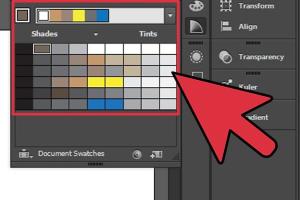Mastering Color in Adobe Illustrator: A Comprehensive Guide for Beginners

-
Quick Links:
- Introduction
- Understanding Color Theory
- Setting Up Your Workspace
- Creating a Color Palette
- Coloring Techniques in Adobe Illustrator
- Using Global Colors
- Case Studies: Effective Use of Color
- Conclusion
- FAQs
Introduction
Coloring in Adobe Illustrator is not just about filling shapes with colors; it’s about understanding how colors interact, evoke emotions, and enhance your designs. In this comprehensive guide, we will delve into various aspects of coloring in Illustrator, including techniques, tips, and best practices to elevate your graphic design skills.
Understanding Color Theory
Before diving into the technical aspects of coloring in Illustrator, it is essential to grasp the basics of color theory. Color theory provides a framework for understanding how colors interact, which can significantly impact your design choices.
The Color Wheel
The color wheel is a visual representation of colors arranged according to their chromatic relationship. It consists of primary, secondary, and tertiary colors:
- Primary Colors: Red, Blue, Yellow
- Secondary Colors: Green, Orange, Purple (formed by mixing primary colors)
- Tertiary Colors: Combinations of primary and secondary colors (e.g., Red-Orange)
Color Harmony
Color harmony is the aesthetically pleasing arrangement of colors. Common color harmonies include:
- Complementary: Colors opposite each other on the color wheel.
- Analogous: Colors next to each other on the color wheel.
- Triadic: Three colors evenly spaced around the wheel.
Setting Up Your Workspace
Creating a comfortable workspace can enhance your workflow while coloring in Illustrator. Here’s how to set it up:
Customizing the Toolbar
Go to Window > Toolbars and select Advanced to access all tools, including those for coloring.
Color Panels
Open the Color and Swatches panels from the Window menu. These panels will be your primary tools for choosing and applying colors.
Creating a Color Palette
A color palette is essential for maintaining consistency in your designs. Here’s how to create one:
Using the Color Guide
The Color Guide panel can suggest harmonious color combinations based on your selected color. Access it via Window > Color Guide.
Saving Custom Swatches
To save a color, select it, then click on the New Swatch button in the Swatches panel. Name your swatch for easy identification later.
Coloring Techniques in Adobe Illustrator
Now that you understand color theory and how to set up your workspace, let’s explore various coloring techniques:
Using the Live Paint Bucket Tool
The Live Paint Bucket tool allows you to fill areas of your design quickly. Here’s how to use it:
- Select your artwork.
- Go to Object > Live Paint > Make.
- Use the Live Paint Bucket tool to fill areas with colors from your palette.
Gradients and Patterns
Gradients can add depth to your designs. To apply a gradient:
- Select the object.
- Open the Gradient panel via Window > Gradient.
- Choose a gradient type (linear or radial) and adjust the colors.
Using Global Colors
Global colors allow you to change the color of all instances of a color in your design at once. To create a global color:
- Open the Swatches panel.
- Click on the New Swatch button and check the Global option.
- Use this swatch throughout your design.
Case Studies: Effective Use of Color
Let’s look at a couple of case studies that illustrate the effective use of color in design:
Case Study 1: Branding
A well-known beverage company revamped its branding by adopting a complementary color scheme. This change not only improved brand recognition but also increased consumer engagement by 30%.
Case Study 2: Infographics
An educational platform used a triadic color scheme in their infographics, which enhanced readability and user interaction by 50% compared to their previous designs.
Conclusion
Coloring in Adobe Illustrator is a powerful skill that can dramatically enhance your graphic design projects. By understanding color theory, setting up your workspace, creating palettes, and mastering various coloring techniques, you can create stunning designs that resonate with your audience.
FAQs
1. What is the best way to choose colors in Adobe Illustrator?
Using the Color Guide panel can help you find harmonious color combinations based on your selected color.
2. How do I apply a gradient in Illustrator?
Select your object, open the Gradient panel, and choose a gradient type to apply.
3. What are global colors?
Global colors are swatches that, when modified, will update all instances of that color in your design.
4. Can I create my own color palette in Illustrator?
Yes, you can create custom swatches and save them in the Swatches panel for future use.
5. How do I use the Live Paint Bucket tool?
Select your artwork, make it a Live Paint group, and then use the Live Paint Bucket tool to fill in areas with your colors.
6. What is the importance of color harmony?
Color harmony helps create aesthetically pleasing designs that are visually engaging and effective in communicating your message.
7. How can I improve my color selection skills?
Practice using color theory principles, study successful designs, and experiment with different color combinations.
8. Can I import color palettes from other sources?
Yes, you can import color palettes from websites or other design software into Illustrator.
9. How do I export my color palette?
You can export your swatches as an ASE file through the Swatch Library menu.
10. Are there any tools to help with color selection?
Tools like Adobe Color Wheel and Coolors.co can assist you in creating and selecting color palettes.